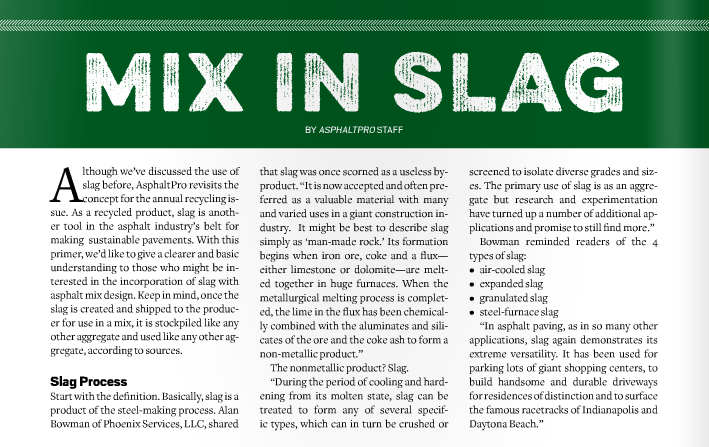Mix In Slag
BY AsphaltPro Staff

Although we’ve discussed the use of slag before, AsphaltPro revisits the concept for the annual recycling issue. As a recycled product, slag is another tool in the asphalt industry’s belt for making sustainable pavements. With this primer, we’d like to give a clearer and basic understanding to those who might be interested in the incorporation of slag with asphalt mix design. Keep in mind, once the slag is created and shipped to the producer for use in a mix, it is stockpiled like any other aggregate and used like any other aggregate, according to sources.
Slag Process
Start with the definition. Basically, slag is a product of the steel-making process. Alan Bowman of Phoenix Services, LLC, shared that slag was once scorned as a useless by-product. “It is now accepted and often preferred as a valuable material with many and varied uses in a giant construction industry. It might be best to describe slag simply as ‘man-made rock.’ Its formation begins when iron ore, coke and a flux—either limestone or dolomite—are melted together in huge furnaces. When the metallurgical melting process is completed, the lime in the flux has been chemically combined with the aluminates and silicates of the ore and the coke ash to form a non-metallic product.”
The nonmetallic product? Slag.
“During the period of cooling and hardening from its molten state, slag can be treated to form any of several specific types, which can in turn be crushed or screened to isolate diverse grades and sizes. The primary use of slag is as an aggregate but research and experimentation have turned up a number of additional applications and promise to still find more.”
Bowman reminded readers of the 4 types of slag:
- air-cooled slag
- expanded slag
- granulated slag
- steel-furnace slag
“In asphalt paving, as in so many other applications, slag again demonstrates its extreme versatility. It has been used for parking lots of giant shopping centers, to build handsome and durable driveways for residences of distinction and to surface the famous racetracks of Indianapolis and Daytona Beach.”
Slag Specs
Keep in mind, racetracks demand strength, stability and, above all, skid-resistance. “Whether in plant mixes, surface seal or slurry applications, the qualities that are required in turnpike surfacing are also found desirable on local projects. Friction and pavement stability are the top performance characteristics.”
Bowman stated that “no aggregate” can compare to the performance of steel slag as an aggregate in asphalt mixes.
“Steel slag can provide a renewable friction surface giving the pavement a long life and offers additional safety to the motoring public. It resists rutting and shoving to provide a smooth ride for the driving public. This resists hydro-planing in wet conditions.”
As for mix design, Bowman shared that “steel and blast furnace slag is often used as 100 percent of total aggregate in the mixture. The mixture depends on the application and cost. High performance mixtures cost more than a lesser performing mixtures.”
“Slag aggregates typically are made to same specifications as natural aggregates,” Bowman said. “Phoenix Services LLC provides responsive world-class service to steel producers around the globe. Core services include slag handling utilizing slag pot carriers or the traditional slag pit digging with front-end loaders; the recovery and sizing of metal to our customer’s specification; and processing slag for use by our steel mill customer or marketing processed slag material for aggregate use. We have established regional facilities to process slag and products from steel mills. Incoming materials are processed, crushed and screened to size, to maximize the recovery of metallic. Residual materials are then marketed as aggregate products.”
As with other aggregates, Bowman shared that slag also has a short transportation region. “To be competitive we have to be close to the source, often within 45 miles. Sometimes more. It depends on customer need. States where slag is produced have specifications for the use of slag aggregate. All of our material (BFS), (BOF) and EAF are all crushed and screened into stockpiles. Many times samples are taken in 40 to 50-pound totes or buckets as needed for mix designs.”
The number of states embracing the use of slag in asphalt mix design depends on two factors: availability and state DOT requirements. “Some customers or state engineers have a bias against use of recycled or manmade products,” Bowman said. “Some have a lack of understanding of high performance mixtures. These are issues we as an industry try to overcome. Slag mixtures are recognized as a very good performing mixture where available.”
